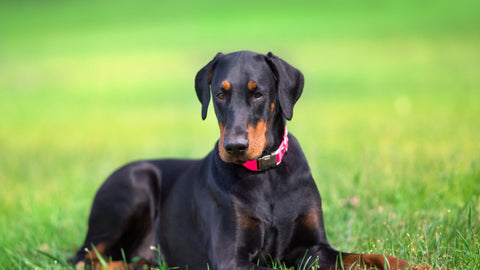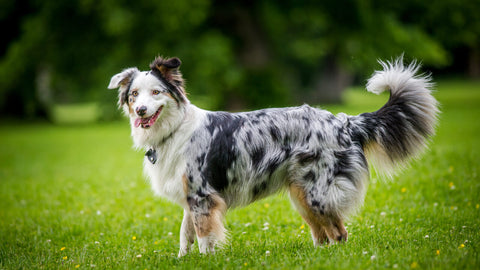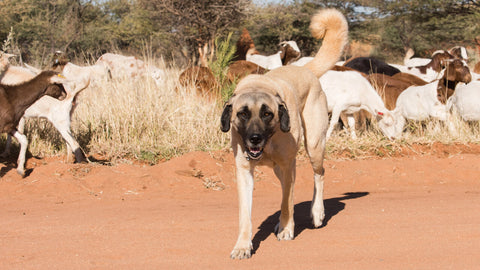Contents
- Introduction to the Dobermann
- Appearance of the Dobermann
- Coat and colours of the Dobermann
- How big can a Dobermann get
- The character of the Dobermann
- Training the Dobermann
- For whom is the Dobermann suitable
- Is the Dobermann a family dog
- Care of the Dobermann
- Nutrition of the Dobermann
- How much does a Dobermann shed
- How old does a Dobermann get
- Typical diseases of the Dobermann
- How much does a Dobermann puppy cost
- What to look out for when buying a Dobermann
- Characteristics of the Dobermann
Introduction to the Dobermann
The Dobermann is an elegant and strong breed of dog that is characterised by its intelligence, loyalty and alertness. It was bred in Germany at the end of the 19th century by Friedrich Louis Dobermann, who was looking for the ideal combination of watchdog, working dog and companion dog. With its striking appearance and alert nature, the Dobermann is considered a versatile dog that can be used both as a family dog and as a working dog.
Appearance of the Dobermann
The Dobermann is a medium to large-sized dog with a muscular and athletic build. Its physique is harmonious and balanced, giving it a graceful yet powerful appearance. The breed is characterised by a long, narrow head with a strong jaw and well-defined stop. The eyes are almond-shaped and expressive, while the ears are either cropped and erect or left uncropped and hanging, depending on the country and attitude. Its tail is usually kept short to support its work as a guard and protection dog.
Coat and colours of the Dobermann
The Dobermann's coat is short, smooth and shiny. It lies close to the body and has no undercoat. The most common colours are black with rust-brown markings and brown with rust-brown markings. These characteristic markings are located above the eyes, on the muzzle, chest, legs and under the tail. Rarely, there are also blue or isabella (fawn-brown) Dobermans, but these are considered a fault in some breeding associations and are therefore less common.
How big can a Doberman grow?
Dobermans are strong dogs with an average shoulder height of 63 to 72 cm. Males usually reach a height of 68 to 72 cm and a weight of 40 to 45 kg, while females are usually slightly smaller and lighter, with a height of 63 to 68 cm and a weight of 32 to 35 kg. This size gives them an imposing and majestic appearance, without making them appear excessively heavy or cumbersome.
The character of the Dobermann
The Dobermann is known for its intelligence, energy and fearlessness. It is alert, attentive and has a strong protective instinct, which is why it is often used as a guard dog. At the same time, however, it is also very affectionate and loyal to its family. Its ability to learn and its desire to please its owner make it an excellent working dog. However, it needs consistent and loving training to reach its full potential.
Training a Dobermann
Training a Dobermann requires experience and patience. These dogs are very intelligent and learn quickly, but they can also be stubborn and headstrong. Early socialisation is important to prevent unwanted behaviour and to get the dog used to different environments and situations. Clear, loving but consistent leadership is essential to channel the Dobermann's strong character in the right direction. Positive reinforcement and regular training are the key to a well-trained Dobermann.
Who is the Dobermann suitable for?
The Dobermann is not necessarily a dog for first-time owners. It is best suited for people who already have experience with dogs and have the necessary time and energy to keep this active and intelligent dog occupied. They need to be kept physically and mentally active to be balanced and happy. Sporty people or those who enjoy participating in dog sports such as obedience, agility or Schutzhund training will get a lot of enjoyment out of a Dobermann.
Is the Dobermann a family dog?
The Dobermann can be an excellent family dog if it is properly socialised and trained. It is usually very affectionate and protective of its family, including children. However, it is important that children respect the dog and learn how to interact with it safely and respectfully. Due to its temperament and size, interactions between young children and Dobermanns should always be supervised.
Grooming the Dobermann
The Dobermann is relatively easy to care for. Its short, smooth coat only needs to be brushed occasionally to remove dead hairs and maintain its shine. It only needs to be bathed if it gets very dirty. It is important to regularly check and clean its ears and to trim its claws if they do not wear down naturally. Dental care should not be neglected either, to prevent tartar and gum disease.
Nutrition of the Dobermann
The Dobermann's diet should be balanced and adapted to its needs. High-quality dog food with a high proportion of meat and little grain is ideal. Since Dobermans can suffer from bloating and gastric torsion, meals should be divided into two to three portions per day. It is also advisable to allow them a period of rest after eating and to refrain from excessive drinking or playing immediately after eating.
How much do Dobermans shed?
Since the Dobermann has a short, smooth coat with no undercoat, its hair loss is relatively low compared to other breeds. Regular brushing helps to remove the loose hairs and minimise hair loss. During the coat change in spring and autumn, hair loss can be a little more pronounced, but overall it is easy to manage.
What is the average age of a Dobermann?
The life expectancy of a Dobermann is on average 10 to 13 years. With good care, a balanced diet and regular veterinary check-ups, the dog can age healthily. Some Dobermanns also reach an older age, although this depends heavily on individual health and genetic factors.
Typical diseases of the Dobermann
Dobermanns are prone to some breed-specific diseases. These include dilated cardiomyopathy (a heart muscle disease), von Willebrand's disease (a blood clotting disorder) and hip dysplasia. Stomach torsion and Wobbler syndrome (a disease of the cervical spine) also occur more frequently in this breed. Regular health checks and responsible breeding are important to minimise these conditions.
How much does a Dobermann puppy cost?
The cost of a Dobermann puppy is usually between CHF 1200.00 and CHF 2500.00, depending on the breeding line, the breeder and the parentage of the parents. Puppies from recognised breeding associations that meet special health checks and requirements can be more expensive. It is important to not only look at the price, but also at the seriousness of the breeder and the health of the puppies.
What should you watch out for when buying a Dobermann?
When buying a Dobermann puppy, you should make sure to choose a reputable breeder who raises their animals in a healthy and species-appropriate environment. The parents should be tested for breed-related illnesses, especially heart problems and von Willebrand's disease. The puppy should be well socialised and make a friendly, open impression. It is also a good sign if the breeder asks about the circumstances of their dog to ensure that it is going to good hands.
Characteristics of the Dobermann
Origin: Germany
Height: Males: 68-72 cm, females: 63-68 cm
Weight: Males: 40-45 kg, females: 32-35 kg
Life expectancy: 10-1 3 years
Coat: Short, smooth, shiny, without undercoat
Colours: Black or brown with rust-coloured markings, rarely blue or isabella
Character: Intelligent, alert, loyal, brave, affectionate
Care: Low maintenance, regular brushing, checking their ears and teeth
Exercise needs: High, needs a lot of physical and mental stimulation
Suitable for: Experienced dog owners, sporty families, people interested in dog sports
Typical diseases: Dilated cardiomyopathy, von Willebrand's disease, hip dysplasia




Comments (0)
There are no comments for this article. Be the first one to leave a message!